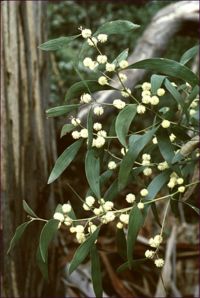Acacia melanoxylon
Acacia melanoxylon {{{latin_name}}}
|
Blackwood
| ||||||||||||||||||||||||||||||||||||||||
|---|---|---|---|---|---|---|---|---|---|---|---|---|---|---|---|---|---|---|---|---|---|---|---|---|---|---|---|---|---|---|---|---|---|---|---|---|---|---|---|---|---|

|
|
| |||||||||||||||||||||||||||||||||||||||
| |||||||||||||||||||||||||||||||||||||||||
Blackwood (Acacia melanoxylon) is a common tree in South-eastern Australia, It is named for the dark heartwood of the tree which produces a timber much favoured in furniture making.
The tree can grow to 30m in height and has very dense dark green foliage. As a young tree it shows typical Acacia foliage, with bipinnate leaves, but these are quickly replaced by expanded leaf stalks known as phyllodes that resemble simple parallel-veined leaves.
| Standard Cyclopedia of Horticulture |
|---|
|
Acacia melanoxylon, R. Br. Blackwood Acacia. Fig. 72. A good - sized evergreen tree of pyramidal form and dense foliage: phyll. oblanceolate to lanceolate, usually one edge straight, the other curved, 2 1/2 - 4 1/2in. long (average 3 1/2 in. long by 3/4in. wide), 3-6 parallel nerves, reticulately veined between; gland 1/6in. from base: fls. cream-color, 40-50 in a head, with peduncles over 1/2in. long, and in short racemes of 3-5 heads: pod reddish brown, with nerve-like margins, more or less twisted into shape of letter C or S, 3-5 in. long, 3/8in. wide; seed longitudinal, 1/8in. in length, encircled in double fold by a long red funicle which is very characteristic of the species, the seed hanging on the trees thus for months; pods ripe July-Nov. Fls. late Feb. and March. B.M. 16.59.—Its wood is but little inferior to black walnut for furniture-making and grillwork; it makes a good street tree in Calif, and as a fuel it is equal to hickory.
|
- More information about this species can be found on the genus page.
Cultivation
| calendar? | ||
|---|---|---|
| January: | ||
| February: | ||
| March: | ||
| April: | ||
| May: | ||
| June: | ||
| July: | ||
| August: | ||
| September: | ||
| October: | ||
| November: | ||
| December: | ||
| Notes: | ||
- Do you have cultivation info on this plant? Edit this section!
Propagation
- Do you have propagation info on this plant? Edit this section!
Pests and diseases
- Do you have pest and disease info on this plant? Edit this section!
Varieties
Gallery
-
Juvenile tree
-
Juvenile leaf
-
Transitional leaf
-
Adult foliage (phyllodes)
-
Pods and seeds on tree
-
Pods and seeds
References
External links
- w:Acacia melanoxylon. Some of the material on this page may be from Wikipedia, under the Creative Commons license.
- Acacia melanoxylon QR Code (Size 50, 100, 200, 500)





